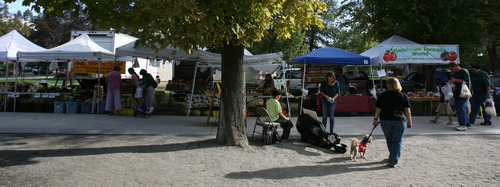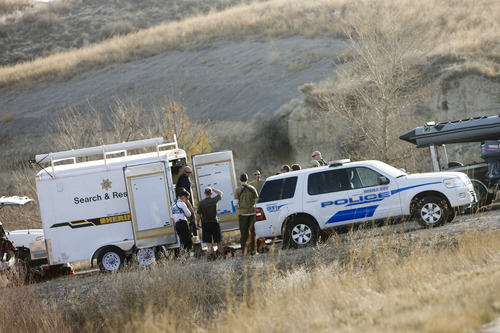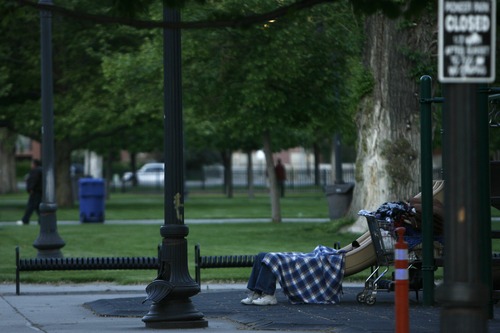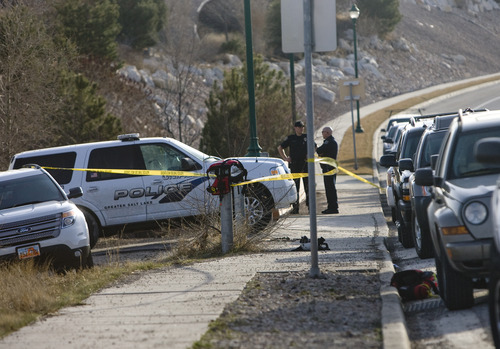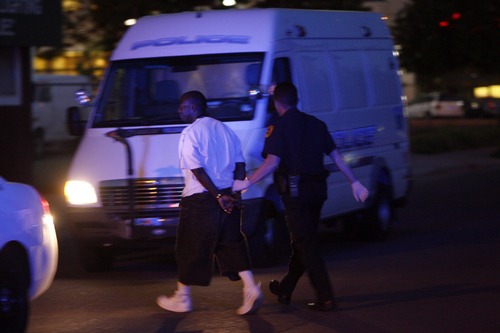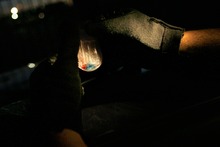This is an archived article that was published on sltrib.com in 2013, and information in the article may be outdated. It is provided only for personal research purposes and may not be reprinted.
Pioneer Park in downtown Salt Lake City is something of a problem child among parks in Utah's most urban county.
City residents may associate the block-sized, tree-lined space at 400 South and 300 West with the homeless, or the summer Downtown Farmers Market on Saturdays, or more recently as the venue for the Twilight Concert Series. But the park also was the site of more than 1,000 incidents involving police in 2011, according to a data-mapping analysis by The Salt Lake Tribune.
That was at least twice as many incidents as the next most crime-involved park system in Salt Lake County, green spaces abutting the Jordan River, a series of dozens of separate parks winding intermittently through Salt Lake City, South Salt Lake and nine other cities.
And the next highest parks for 2011 police incidents after that — Library Square and the City-County block in Salt Lake; Murray City Park; and Salt Lake's Liberty Park — had about 160 calls apiece, according to a Tribune database analysis of crime incidents in 2011.
The findings are no surprise to Salt Lake City police.
"It definitely is a park that has a lot of traffic," police Sgt. Shawn Josephson said of Pioneer Park, noting that between the annual farmers market, the popular Twilight concerts and the park's proximity to several homeless shelters, thousands of people visit it annually.
"It has been problematic for years," he said. "So it's definitely one we're constantly watching and trying to reduce the crimes."
What's more, the Occupy Salt Lake protesters lived in the park last year, adding calls to the tally in connection with at least one death and numerous arrests and altercations. And with officers frequently present at events for crowd control, many criminal violations came to light that might otherwise have gone unnoticed.
Police installed four surveillance cameras in Pioneer in 2009. The program of passive surveillance — only reviewing captured footage after a crime is reported — has drawn criticism from civil rights groups as a violation of privacy and the constitutional right to gather without government interference. Police have anecdotal evidence the cameras are lowering crime rates.
"It doesn't completely take it away, but it makes people think twice before doing something illegal," Josephson said of the cameras.
In 2012 through November, Josephson noted, there had been about 830 crimes at the park, on track for a year-to-year decline from 2011. Mapping analysis reveals that the area within a four-block radius around Pioneer remains among the heaviest in downtown Salt Lake City for criminal activity.
Pioneer's location affects not only crime rates but also the kinds of incidents drawing officers to the park. Josephson noted that more than 250 of verified crimes at Pioneer involved illegal liquor possession and another 350 were tobacco violations.
"Those numbers are significantly higher than they would be elsewhere," he said. "People who stay at the shelter, they can't go into the shelter and [drink], so they'll typically go into the park and do that."
Police incidents on Library Square and the City-County Building block skew in a similar way, with nearly half of all incidents either tobacco or liquor and public intoxication violations.
But the trend for the downtown parks runs counter to an overall pattern for parks in Salt Lake County, which The Tribune's analysis shows are relatively free of crime and other incidents requiring police involvement.
The analysis involved computer mapping data on 230,409 crime incidents, provided by 14 law enforcement agencies in Salt Lake County in response to public-records requests — 11 city police departments, the University of Utah campus police, Salt Lake International Airport and the Salt Lake Unified Police Department, which patrols five cities and four townships in the county as well as unincorporated areas.
The mapping analysis found 2,828 police calls occurred inside or within 5 feet of the more than 500 municipally run and special-use parks and open spaces located within county boundaries, amounting to fewer than three of every 200 incidents overall involving police in 2011.
Several police agencies said even those numbers may be high, due to technical quirks in the ways they assign geographic locations to crimes and proximity of many parks to high-traffic retail and residential locations that have their own crime problems.
With nearly 80 percent of all parks calls in 2011 centering on 20 parks, the remaining 600 or so police incidents were spread among hundreds of neighborhood, city and county green spaces, meaning most parks in the county saw little if any crime.
About one in three police incidents in 2011 within park boundaries involved investigating suspicious activity, tobacco or alcohol-related citations including public intoxication, lost property, rendering assistance and enforcement of other ordinances drawing tickets rather than arrests, data indicate.
Assault was the most common criminal incident in or just outside a public park, but was still only about 17 percent of the total detected in the analysis.
About 5 percent of park incidents county-wide were drug-related, the analysis indicates. That percentage was only slightly higher for Pioneer Park, at 6.4 percent. And another 5 percent involved arrests for outstanding warrants, both for Pioneer and for parks across the county.
Crime levels in urban parks are tied to a complex web of factors, including the landscape and size of parks and the crime rates and demographics of surrounding areas, according to a 2011 study by criminal-justice researchers at Temple University.
The study looked at neighborhood parks and crime patterns in Philadelphia and concluded, among other things, that crime is rarely spread evenly among city parks and that heavy foot traffic through a park doesn't always correlate with high crime rates but can instead sometimes deter crime by putting more "eyes on the street."
A park's geography also has an obvious impact on how it is policed.
Salt Lake City police patrol Pioneer Park with a mix of officers on foot, in cars and on bicycles. In contrast, cops work the long, narrow and heavily wooded Jordan River Parkway primarily on bicycles or ATVs, paying special attention to trails and secluded areas, according to Lt. Justin Hoyal, spokesman for the Unified Police Department of Greater Salt Lake, which has jurisdiction over several stretches of the parkway.
"[Our officers] will get back in there and just be visible as a deterrent, to be proactive'' Hoyal said.
@sltribjanelle
@Tony_Semerad —
Top 10 Salt Lake County parks with most crime in 2011
Rank Park name City Crime incidents
1 Pioneer Park Salt Lake 1021
2 Jordan River Pkwy. Salt Lake 274
3 Library Square Salt Lake 168
4 Murray City Park Murray 164
5 Liberty Park Salt Lake 161
6 Jordan River Pkwy. Taylorsville-Murray 133
7 Sugar House- Hidden Hollow Salt Lake 78
8 Hogle Zoo/Rotary Glen/ Donner Trail Salt Lake 38
9 Flat Iron Mesa Park Sandy 29
10 City Creek- Memory Grove Salt Lake 26
Most common types of crimes in parks countywide
Type How many
Assault 507
Tobacco-related 383
Public ordinance 373
Public order/peace 307
Traffic-related 171
Drug-related 157
Larceny 146
Warrants 144
Source: Salt Lake County crime data, various agencies


